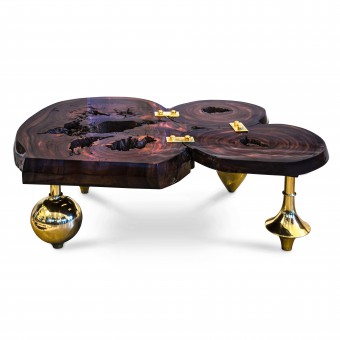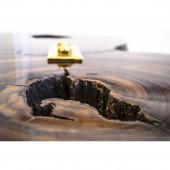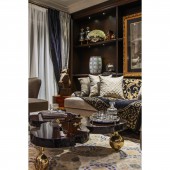Amoeba Coffee table by Yoca Pvt Ltd. |
Home > Winners > #55843 |
 |
|
||||
| DESIGN DETAILS | |||||
| DESIGN NAME: Amoeba PRIMARY FUNCTION: Coffee table INSPIRATION: The inspiration was to create a unique and creative piece from unusable functioning pieces, that are discarded and considered waste. Each piece is developed into an aesthetically pleasing form, in accordance with our design philosophy, to treat every natural element as precious and usable, not discarded. Vernacular forms such as Minaret and Spinning Top inspire the shape of the brass legs. UNIQUE PROPERTIES / PROJECT DESCRIPTION: The trunk of the rosewood tree, which is conventionally the discarded wood by furniture manufacturers, is sliced into sections depending on its own unique shape and size. Each root formation is specifically selected and cut in the direction of the grain, to create the harmony between the different trunks. Each of the three segments are held together by brass rivets, and sit on varying hand crafted brass legs. OPERATION / FLOW / INTERACTION: After the bark is selected, it is aged and dried before putting it through the process of staining. Based on the size of the bark, placement of the hand crafted brass legs come into play. PROJECT DURATION AND LOCATION: Developed in 2014 in Karachi, Pakistan. FITS BEST INTO CATEGORY: Furniture Design |
PRODUCTION / REALIZATION TECHNOLOGY: Materials are tree bark, hand sculpted brass, solvent stains, high gloss acrylic top coat.The Amoeba coffee table is all handmade. Each table takes 30 days to produce. Rosewood thickness varies between 63.5 mm- 76 mm.The selected pieces are then aged by natural aeration. The top is naturally stained and coated with high gloss acrylic top coat, to enhance the richness of the grains SPECIFICATIONS / TECHNICAL PROPERTIES: Material: 63.5 mm- 76 mm Rosewood thickness. Dimensions: 1220 mm (W) x 508 mm (D) x 407 mm (H) Dimensions are variable as it is produced from a natural product depending on the availability of barks TAGS: Yoca, Najmi Bilgrami, Amoeba, Amoeba Coffee Table, Sarah Najmi Bilgrami, Syed Zayd Bilgrami, Ahsan Najmi RESEARCH ABSTRACT: The research involved exploration of the geometry of the legs. Different modules were made to explore strength, stability, balance and symmetry of table. Also research was done to determine the placement of the legs. Because the bark is natural, each table has a slight modification for the placement of the legs. CHALLENGE: The creative challenge is finding the bark which are the discarded items from the rosewood tree trunk, and in finding 2-3 barks that complement each other to form a cohesive whole. ADDED DATE: 2017-02-28 15:55:59 TEAM MEMBERS (3) : Sarah Najmi Bilgrami, Syed Zayd Bilgrami and Ahsan Najmi IMAGE CREDITS: Yoca Pvt Ltd. , 2016. |
||||
| Visit the following page to learn more: https://www.yocainc.com | |||||
| AWARD DETAILS | |
 |
Amoeba Coffee Table by Yoca Pvt Ltd is Winner in Furniture Design Category, 2016 - 2017.· Read the interview with designer Yoca Pvt Ltd. for design Amoeba here.· Press Members: Login or Register to request an exclusive interview with Yoca Pvt Ltd. . · Click here to register inorder to view the profile and other works by Yoca Pvt Ltd. . |
| SOCIAL |
| + Add to Likes / Favorites | Send to My Email | Comment | Testimonials | View Press-Release | Press Kit |
Did you like Yoca Pvt Ltd's Furniture Design?
You will most likely enjoy other award winning furniture design as well.
Click here to view more Award Winning Furniture Design.








